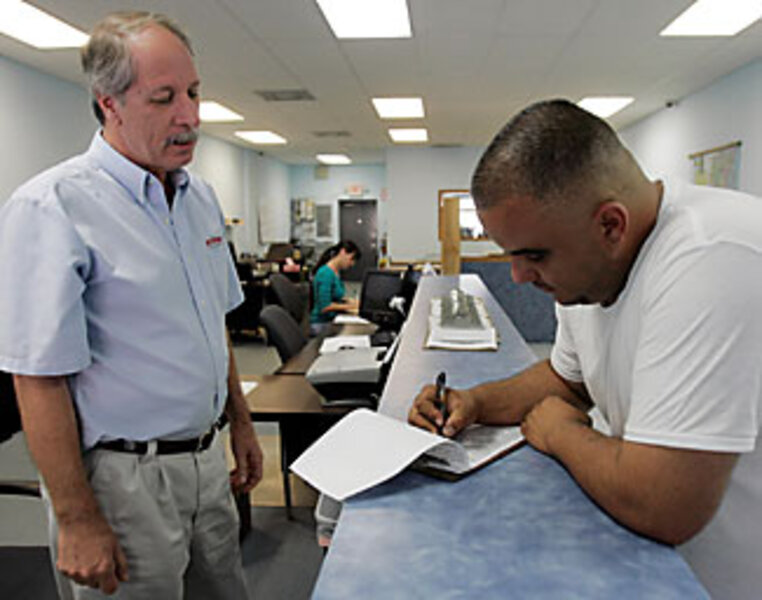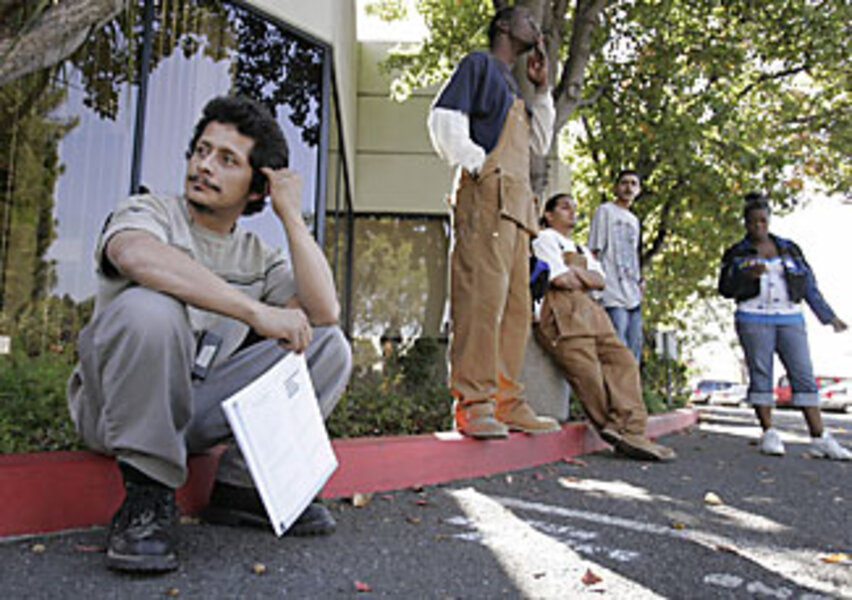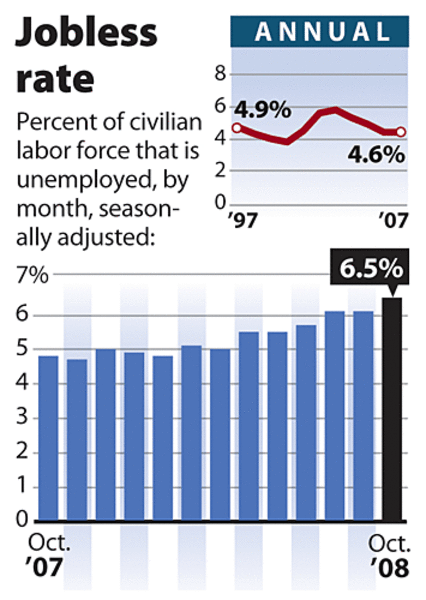Are jobless next to need a bailout?
Loading...
| New York
The nation's economic focus is turning from saving the banking system to how to provide a rapidly rising tide of jobless with benefits and a road map to employment.
And, just as there was a flashing-red- light urgency to the banking crisis, economists say the same haste has to be taken to deal with what is becoming a massive lay-off problem. Dealing with the jobless has already become a priority for President-elect Barack Obama. Congress is now likely to enact a fiscal stimulus package, including extending unemployment benefits, in either its lame duck session or early in the new year.
The risk to the economy is that layoffs cause more Americans to tighten their belts. As they cut back on their purchasing, business reduces its production, laying off yet more workers.
"We are now entering a vicious cycle," says economist Bob Brusca of Fact and Opinion Economics in New York. "It's like a snowball going downhill. If you stop the snowball when it's small, you can stop it. But if you wait too long, it gets too much mass and becomes dangerous."
Even if Congress passes a fiscal stimulus package, economists still expect the ranks of the unemployed to continue to grow.
"I suspect it's going to get worse," predicts John Silvia, chief economist at the Wachovia Economics Group in Charlotte, N.C. "It will just take time. There is no quick solution."
The latest evidence of the layoff problem came Friday when the Labor Department reported that the unemployment rate in October skyrocketed to 6.5 percent, its highest level since February 1994 and up from 6.1 percent in September. The economy shed 240,000 jobs, the second worst month of the year after September, when 284,000 jobs were lost.
How bad can it get? In a normal month, the economy needs to provide 125,000 new jobs. During a bad recession, Mr. Brusca says, the economy can shed as many as 500,000 jobs a month.
"The important thing is that some of the key indicators are now reading as weak or weaker than these deep recessions," says Brusca. "We have every reason to think this is as bad as a deep recession."
The economic numbers are deteriorating so fast that many economists are revising downward their estimates for growth. One is Scott Anderson of Wells Fargo Economics in Minneapolis, which now projects the economy will shrink by 3 to 4 percent in the fourth quarter. He has revised his unemployment forecast to 8 percent from 7.4 percent. An economy operating optimally grows 3 to 4 percent per year.
"The danger is this thing could drag on longer than we thought," he says.
On Friday, at his first press conference, President-elect Obama said he wants to see Congress approve a stimulus package sooner rather than later. "If it does not get done in a lame-duck session, it will be the first thing I do as president of the United States," he said at a press conference at Chicago's Hilton Hotel.
Among his other proposals: an extension of unemployment benefits for those who can't find work and aid to the auto industry and its suppliers.
The multipronged approach appeals to some advocates for the unemployed. In fact, if the American economy continues to falter, "I think the new administration might have to look at a more direct role in job creation," says Andrew Stettner, deputy director of the National Employment Law Project in New York. "You have to look at things that are more dramatic."
In the near term, the employment numbers are likely to remain bleak. Planned job cuts surged 19 percent in October, Challenger, Gray & Christmas, a Chicago-based outplacement firm, reported Nov. 5. According to the firm, employers announced plans to cut 112,884 jobs, the highest amount in five years. So far this year, announced job cuts are up 14 percent over 2007.
"There are now almost 2.8 million people unemployed in the last year chasing fewer jobs," says John Challenger. "So far in 2008, we've had a net loss of 1.2 million jobs."
In addition, some 6.7 million people are working part-time jobs because they can't find full-time employment, he says. This is up from 3.2 million a year ago.
Even those jobs may be in danger. Retailers hired the fewest number of holiday workers since 1991, a recession year, Mr. Challenger has found. Retail hiring is down 19 percent compared with last year. "There will be fewer jobs, no question," says Challenger.
One area that is particularly vulnerable is manufacturing, which lost 90,000 jobs in October.
"We are now seeing horrendous declines in manufacturing activity," says Dan Meckstroth, chief economist at the Manufacturers Alliance/MAPI in Arlington, Va.
Automobile sales are now running at a 10.5 million annual rate, down from 12.5 million in September. The break-even point for Detroit is 16 million vehicles sold per year.
"This is going to affect not just the auto assembly plants, but parts producers and everyone else involved in manufacturing," says Mr. Meckstroth.
On Nov. 6, the Detroit automakers pressed lawmakers for loans to help them get through the downturn. On Nov. 7, Ford said it lost $2.7 billion in continuing operations in the third quarter and had burned through $7.7 billion in cash. It also announced it would lay off 2,260 white-collar workers in North America in the weeks ahead.
Even exports, which had been a pillar for the US economy, are now declining, according to the latest survey from the Institute for Supply Management.
"It is amazing how rapidly conditions have deteriorated," says Meckstroth.
Aside from the loss of jobs in manufacturing, 49,000 construction jobs were lost, along with 38,000 retail jobs, 45,000 professional jobs, and 24,000 positions in finance.







